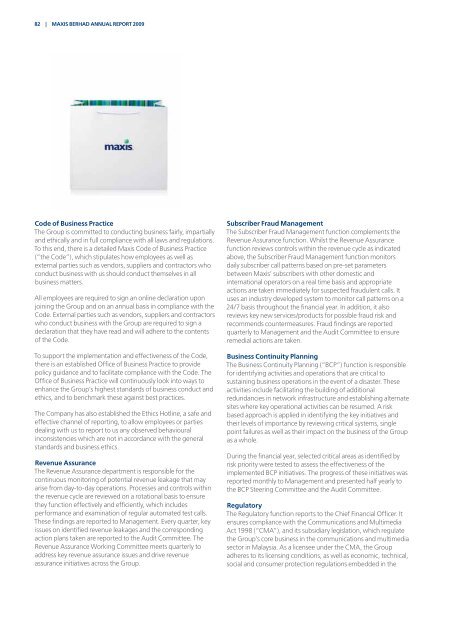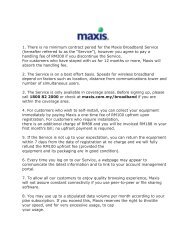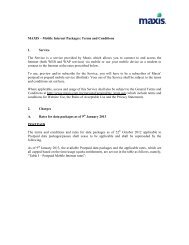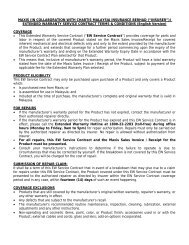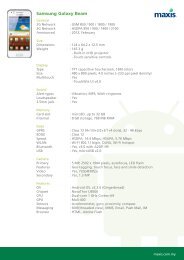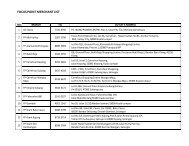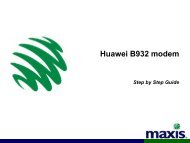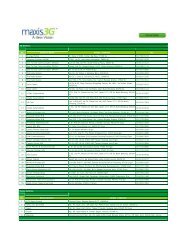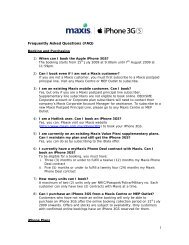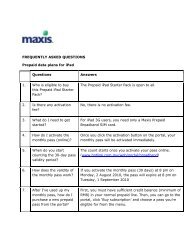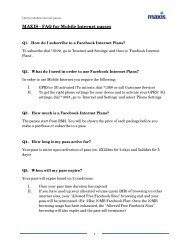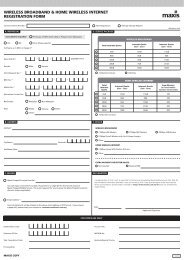annual - Maxis
annual - Maxis
annual - Maxis
Create successful ePaper yourself
Turn your PDF publications into a flip-book with our unique Google optimized e-Paper software.
82 | <strong>Maxis</strong> BERHAD Annual Report 2009<br />
Code of Business Practice<br />
The Group is committed to conducting business fairly, impartially<br />
and ethically and in full compliance with all laws and regulations.<br />
To this end, there is a detailed <strong>Maxis</strong> Code of Business Practice<br />
(“the Code”), which stipulates how employees as well as<br />
external parties such as vendors, suppliers and contractors who<br />
conduct business with us should conduct themselves in all<br />
business matters.<br />
All employees are required to sign an online declaration upon<br />
joining the Group and on an <strong>annual</strong> basis in compliance with the<br />
Code. External parties such as vendors, suppliers and contractors<br />
who conduct business with the Group are required to sign a<br />
declaration that they have read and will adhere to the contents<br />
of the Code.<br />
To support the implementation and effectiveness of the Code,<br />
there is an established Office of Business Practice to provide<br />
policy guidance and to facilitate compliance with the Code. The<br />
Office of Business Practice will continuously look into ways to<br />
enhance the Group’s highest standards of business conduct and<br />
ethics, and to benchmark these against best practices.<br />
The Company has also established the Ethics Hotline, a safe and<br />
effective channel of reporting, to allow employees or parties<br />
dealing with us to report to us any observed behavioural<br />
inconsistencies which are not in accordance with the general<br />
standards and business ethics.<br />
Revenue Assurance<br />
The Revenue Assurance department is responsible for the<br />
continuous monitoring of potential revenue leakage that may<br />
arise from day-to-day operations. Processes and controls within<br />
the revenue cycle are reviewed on a rotational basis to ensure<br />
they function effectively and efficiently, which includes<br />
performance and examination of regular automated test calls.<br />
These findings are reported to Management. Every quarter, key<br />
issues on identified revenue leakages and the corresponding<br />
action plans taken are reported to the Audit Committee. The<br />
Revenue Assurance Working Committee meets quarterly to<br />
address key revenue assurance issues and drive revenue<br />
assurance initiatives across the Group.<br />
Subscriber Fraud Management<br />
The Subscriber Fraud Management function complements the<br />
Revenue Assurance function. Whilst the Revenue Assurance<br />
function reviews controls within the revenue cycle as indicated<br />
above, the Subscriber Fraud Management function monitors<br />
daily subscriber call patterns based on pre-set parameters<br />
between <strong>Maxis</strong>’ subscribers with other domestic and<br />
international operators on a real time basis and appropriate<br />
actions are taken immediately for suspected fraudulent calls. It<br />
uses an industry developed system to monitor call patterns on a<br />
24/7 basis throughout the financial year. In addition, it also<br />
reviews key new services/products for possible fraud risk and<br />
recommends countermeasures. Fraud findings are reported<br />
quarterly to Management and the Audit Committee to ensure<br />
remedial actions are taken.<br />
Business Continuity Planning<br />
The Business Continuity Planning (“BCP”) function is responsible<br />
for identifying activities and operations that are critical to<br />
sustaining business operations in the event of a disaster. These<br />
activities include facilitating the building of additional<br />
redundancies in network infrastructure and establishing alternate<br />
sites where key operational activities can be resumed. A risk<br />
based approach is applied in identifying the key initiatives and<br />
their levels of importance by reviewing critical systems, single<br />
point failures as well as their impact on the business of the Group<br />
as a whole.<br />
During the financial year, selected critical areas as identified by<br />
risk priority were tested to assess the effectiveness of the<br />
implemented BCP initiatives. The progress of these initiatives was<br />
reported monthly to Management and presented half yearly to<br />
the BCP Steering Committee and the Audit Committee.<br />
Regulatory<br />
The Regulatory function reports to the Chief Financial Officer. It<br />
ensures compliance with the Communications and Multimedia<br />
Act 1998 (“CMA”), and its subsidiary legislation, which regulate<br />
the Group’s core business in the communications and multimedia<br />
sector in Malaysia. As a licensee under the CMA, the Group<br />
adheres to its licensing conditions, as well as economic, technical,<br />
social and consumer protection regulations embedded in the


